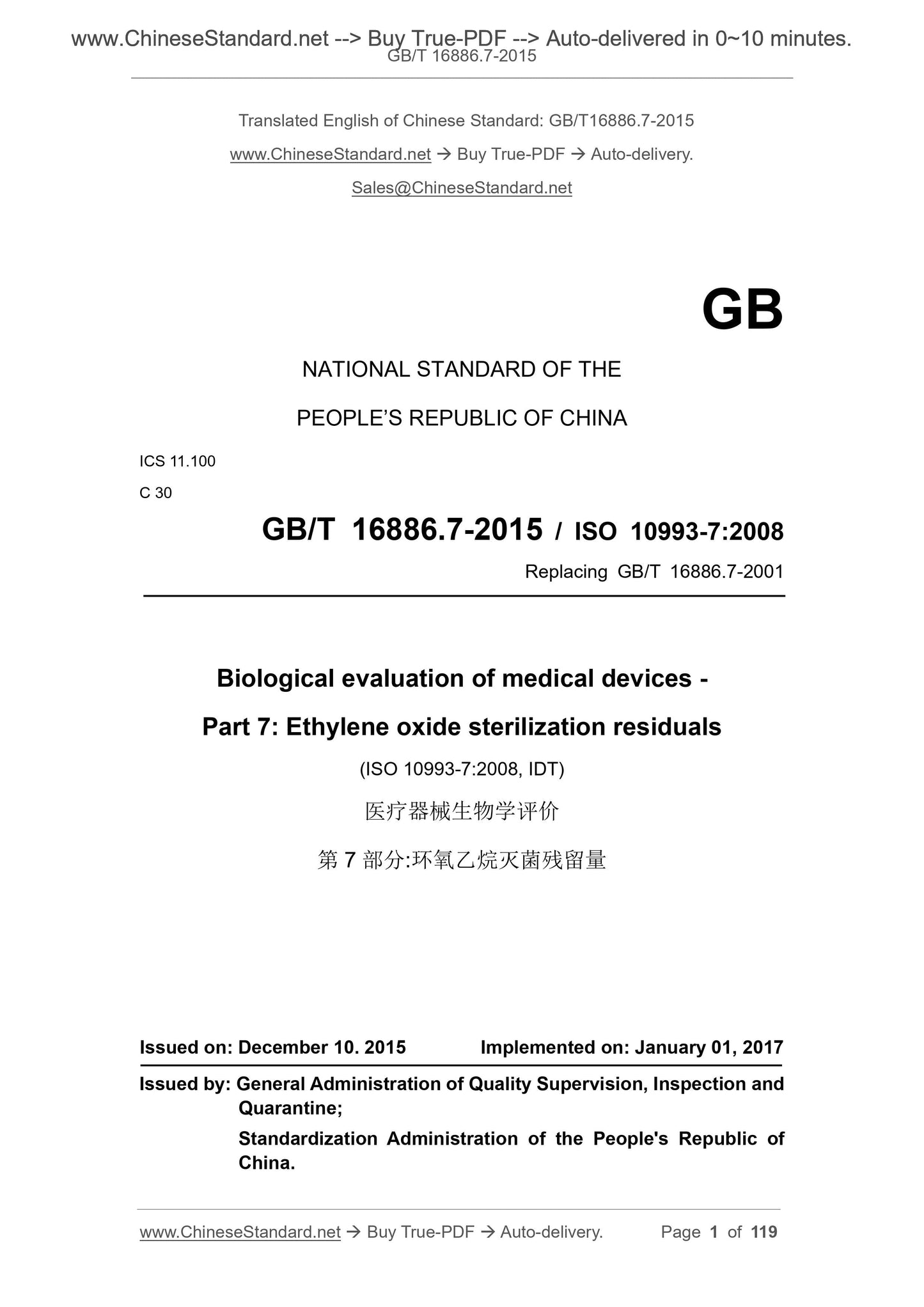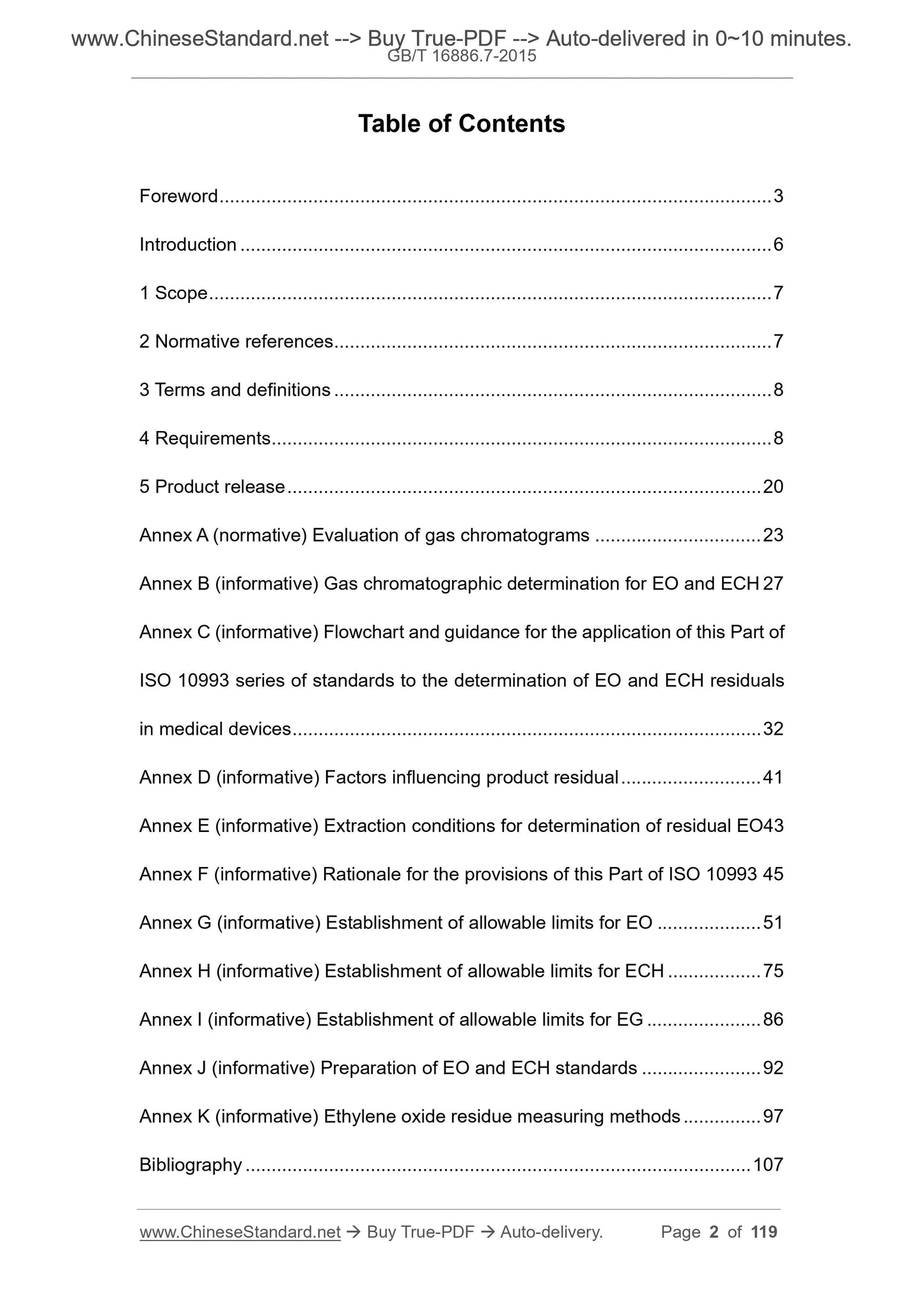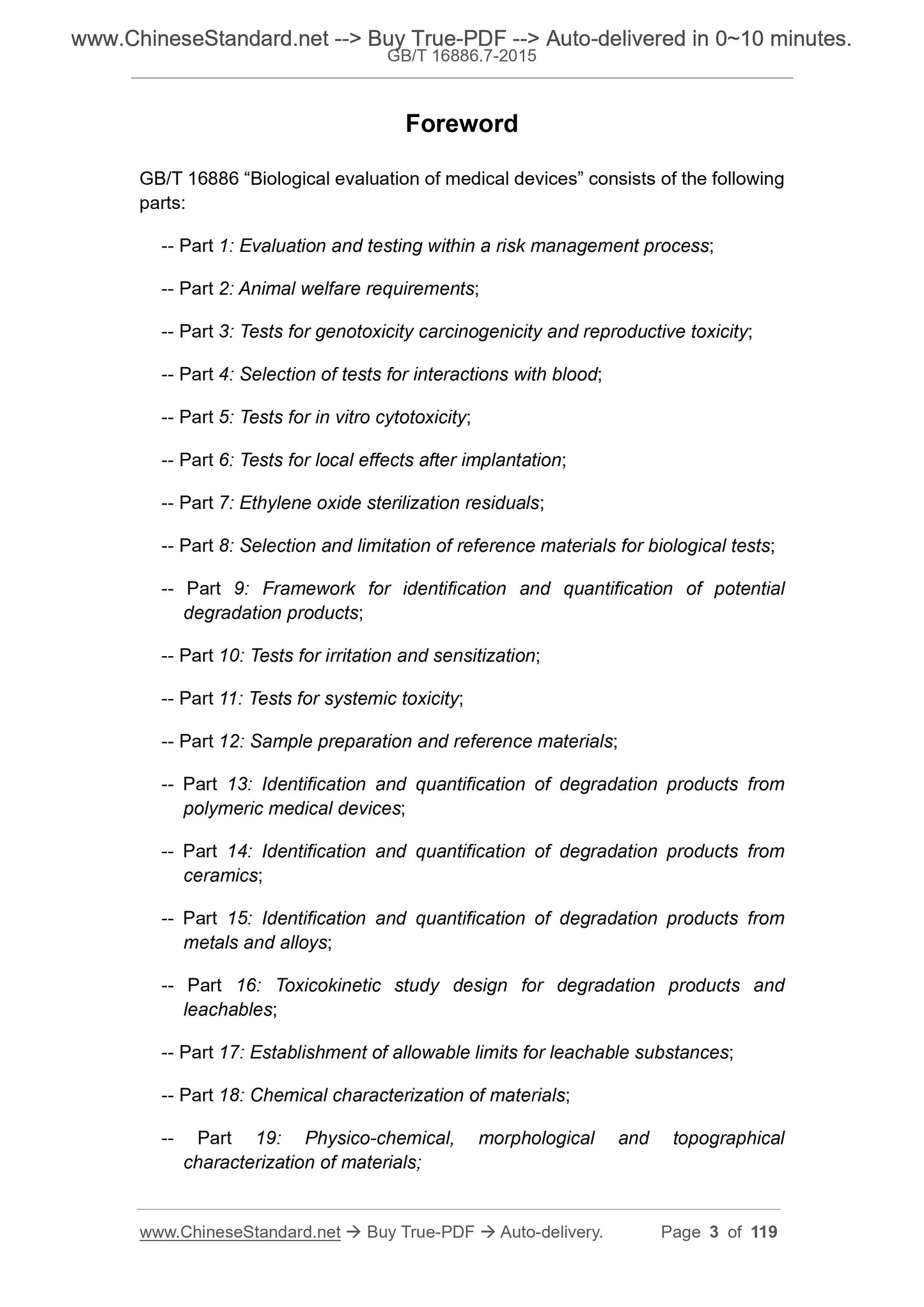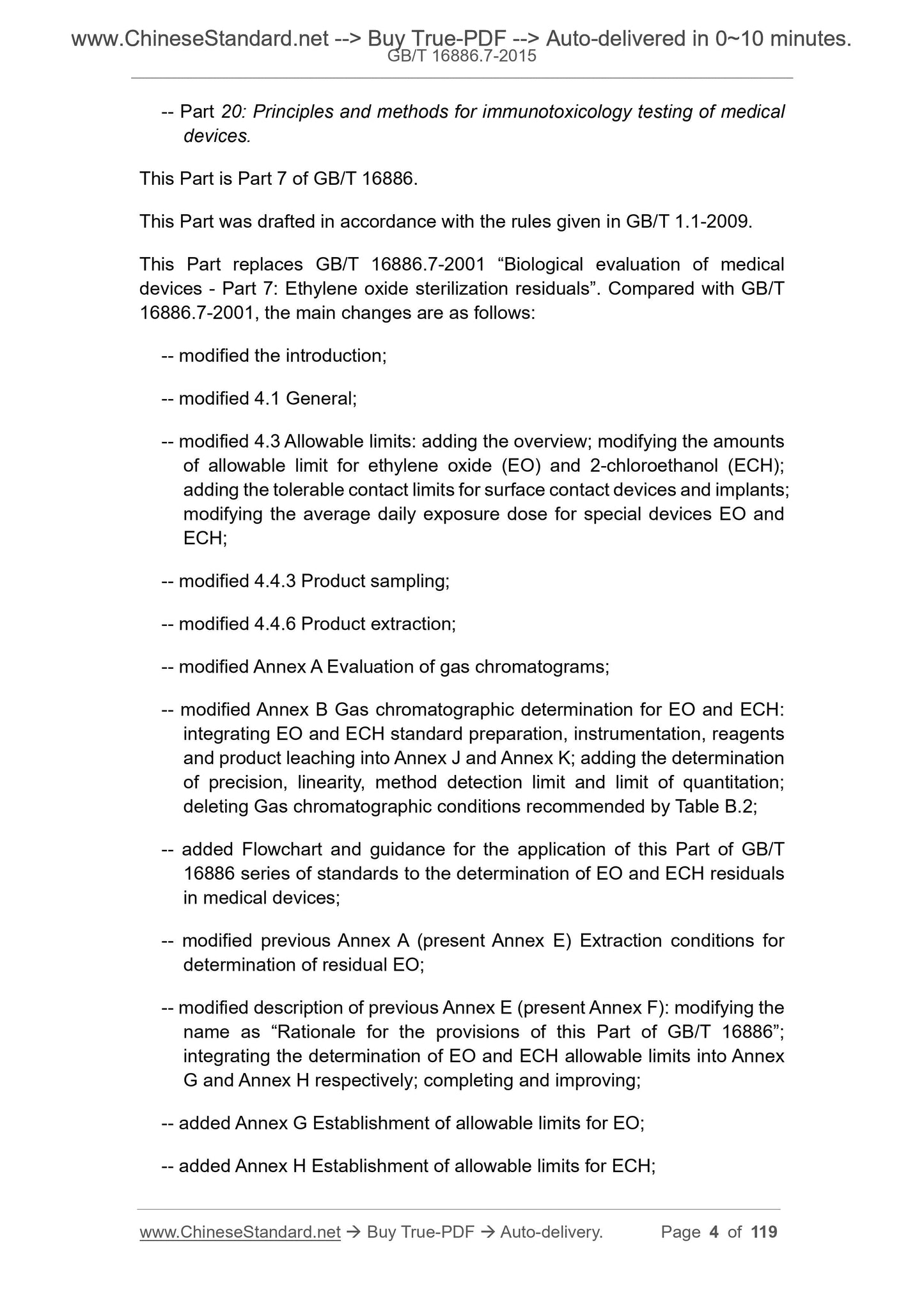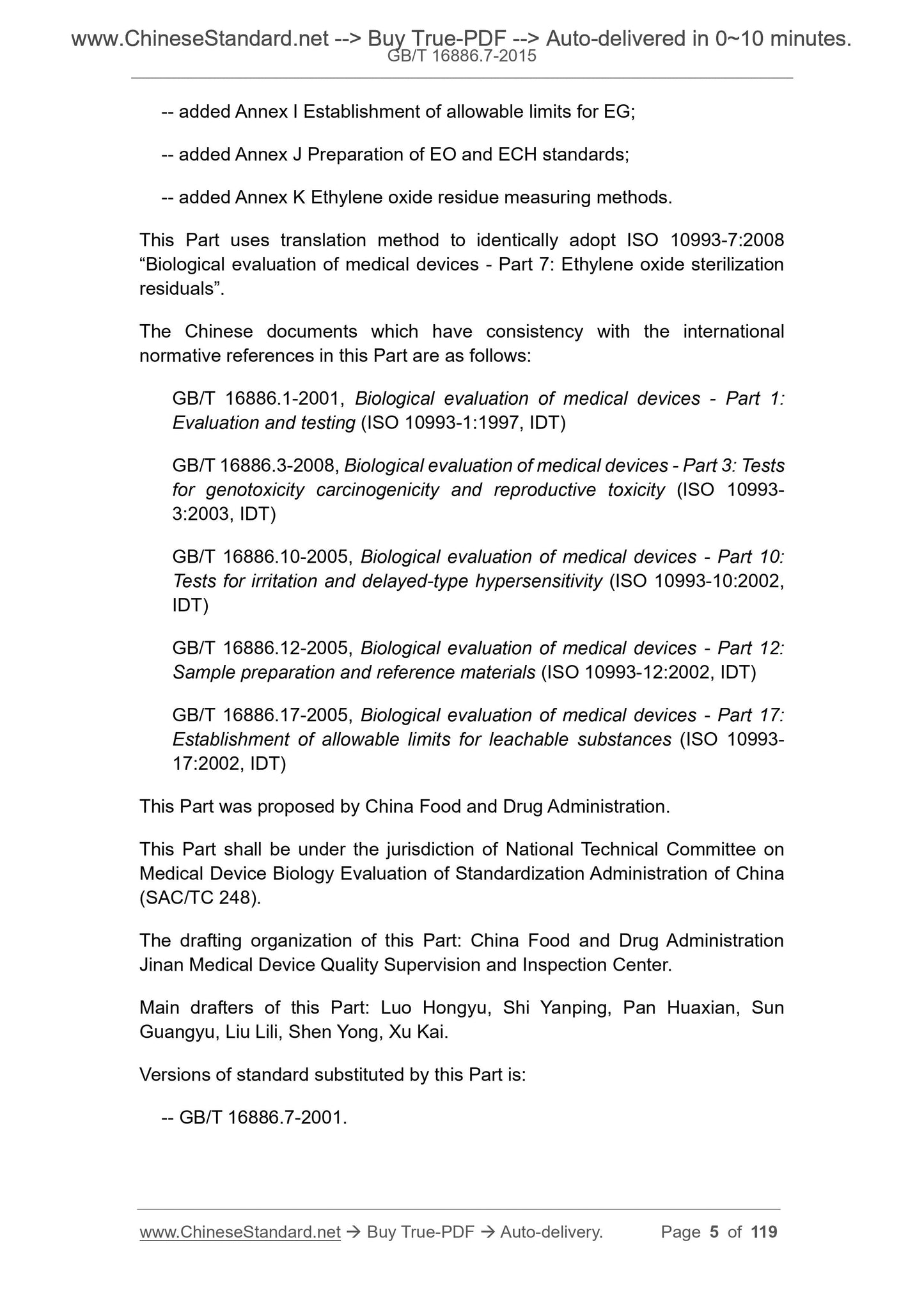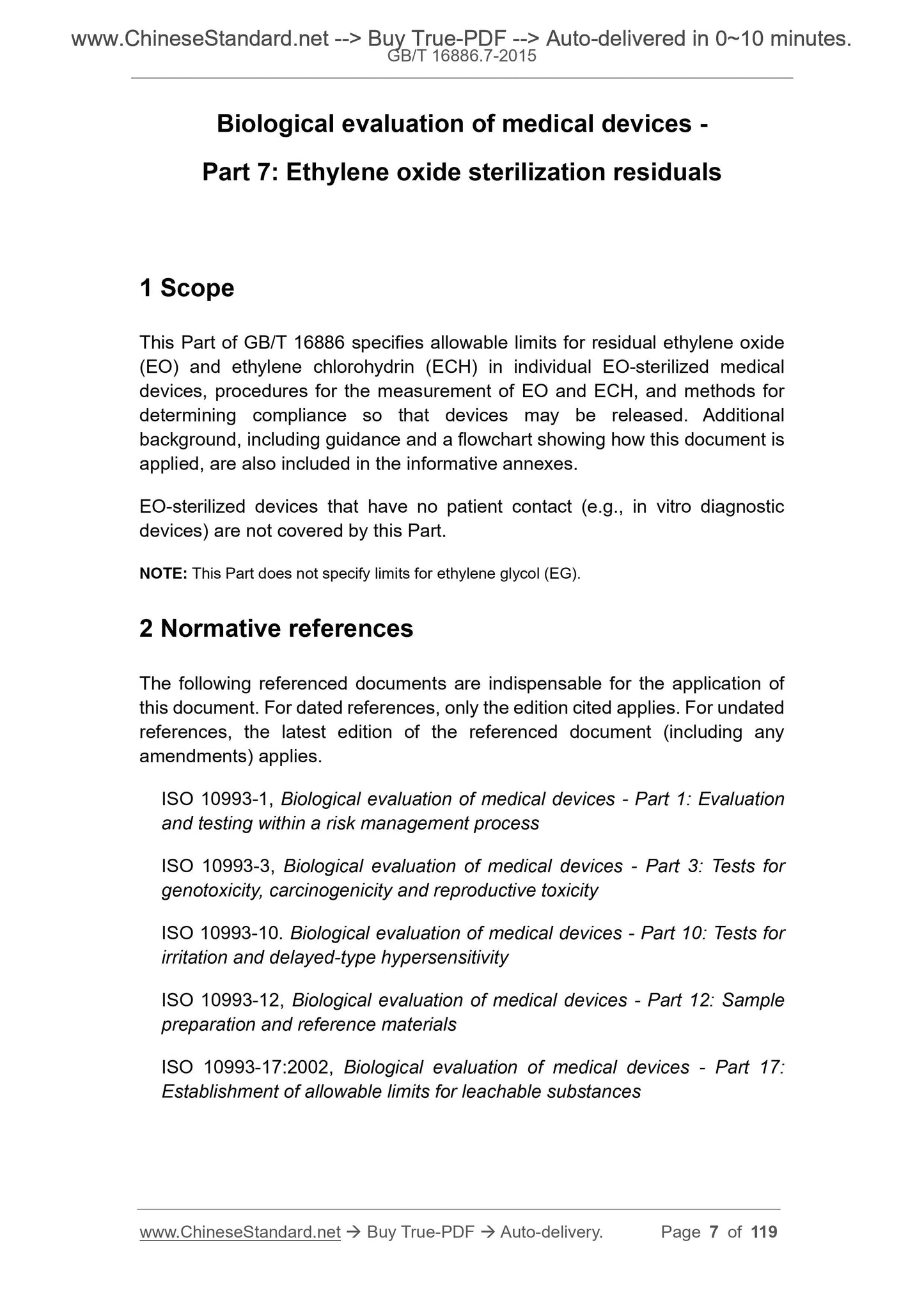1
/
de
6
PayPal, credit cards. Download editable-PDF and invoice in 1 second!
GB/T 16886.7-2015 English PDF (GBT16886.7-2015)
GB/T 16886.7-2015 English PDF (GBT16886.7-2015)
Prix habituel
$495.00 USD
Prix habituel
Prix promotionnel
$495.00 USD
Prix unitaire
/
par
Frais d'expédition calculés à l'étape de paiement.
Impossible de charger la disponibilité du service de retrait
Delivery: 3 seconds. Download true-PDF + Invoice.
Get QUOTATION in 1-minute: Click GB/T 16886.7-2015
Historical versions: GB/T 16886.7-2015
Preview True-PDF (Reload/Scroll if blank)
GB/T 16886.7-2015: Biological evaluation of medical devices -- Part 7: Ethylene oxide sterilization residuals
GB/T 16886.7-2015
Biological evaluation of medical devices - Part 7. Ethylene oxide sterilization residuals
ICS 11.100
C30
National Standards of People's Republic of China
Replace GB/T 16886.7-2001
Medical device biology evaluation
Part 7. Ethylene oxide sterilization residues
Released on December 10,.2015
2017-01-01 implementation
General Administration of Quality Supervision, Inspection and Quarantine of the People's Republic of China
China National Standardization Administration issued
Foreword
GB/T 16886 "Biology Evaluation of Medical Devices" is divided into the following sections.
--- Part 1. Evaluation and testing in the risk management process;
--- Part 2. Animal welfare requirements;
--- Part 3. Genotoxicity, carcinogenicity and reproductive toxicity test;
--- Part 4. Test options for interaction with blood;
---Part 5. In vitro cytotoxicity test;
--- Part 6. Post-implantation local reaction test;
---Part 7. Ethylene oxide sterilization residue;
---Part 9. Qualitative and quantitative frameworks for potential degradation products;
--- Part 10. Stimulation and delayed type hypersensitivity test;
--- Part 11. Systemic toxicity test;
---Part 12. Sample preparation and reference samples;
--- Part 13. Qualitative and quantitative determination of polymer degradation products;
--- Part 14. Qualitative and quantitative determination of ceramic degradation products;
---Part 15. Qualitative and quantitative determination of metal and alloy degradation products;
---Part 16. Design of toxicokinetics of degradation products and solubles;
--- Part 17. The establishment of a limitable amount of leachables;
---Part 18. Chemical characterization of materials;
---Part 19. Physical chemistry, morphological and surface characterization of materials;
--- Part 20. Principles and methods for immunological toxicology testing of medical devices.
This part is part 7 of GB/T 16886.
This part is drafted in accordance with the rules given in GB/T 1.1-2009.
This part replaces GB/T 16886.7-2001 "Biology Evaluation of Medical Devices Part 7. Ethylene Oxide Sterilization Residues", and
Compared with GB/T 16886.7-2001, the main technical contents are changed as follows.
--- Modified the introduction;
--- Revised 4.1 overview;
--- Revised 4.3 Allowable Limits. Added overview; modified ethylene oxide (EO) and 2-chloroethanol (ECH) allowable limits; added
Surface contact devices and implants can withstand exposure limits and modify the average daily contact dose of special devices EO and ECH;
--- Modified 4.4.3 product sampling;
--- Modified 4.4.6 product leaching;
--- Modified Appendix A gas chromatographic evaluation;
--- Modified Appendix B for the determination of EO and ECH by gas chromatography. extraction of EO and ECH standard solutions, instruments, reagents and products
The content is integrated into Appendix J and Appendix K; the precision, linearity, method detection limit and quantitative limit are determined;
Table B.2 Recommended gas chromatographic conditions;
--- Added Appendix C application GB/T 16886 series standard This part determines the process of EO and ECH residues in medical devices
Diagram and guide;
--- Revised the original Appendix D (now Appendix E) to determine the leaching conditions of EO residues;
--- Revised the original Appendix E (now Appendix F) Description. The title of the appendix was changed to "Description of the provisions of this part of GB/T 16886"; EO
And the ECH allowable limit determination is integrated into Appendix G and Appendix H respectively; and supplemented and improved;
--- Increased the determination of Appendix G EO Residue Limits;
--- Added the determination of the allowable limit of Appendix H ECH;
--- Increased the determination of the allowable limit of Appendix I EG;
--- Added preparation of Appendix J EO and ECH standards;
--- Added the test method for Appendix K Ethylene Oxide.
This section uses the translation method equivalent to ISO 10993-7.2008 "Medical Evaluation of Medical Devices Part 7. Residues of Cyclohexyl Ester Sterilization".
The documents of our country that have a consistent correspondence with the international documents referenced in this part are as follows.
GB/T 16886.1-2001 Biological evaluation of medical devices - Part 1. Evaluation and testing (ISO 10993-1..1997, IDT)
GB/T 16886.3-2008 Biological evaluation of medical devices - Part 3. Tests for genotoxicity, carcinogenicity and reproductive toxicity
(ISO 10993-3.2003, IDT)
GB/T 16886.10-2005 Biological evaluation of medical devices - Part 10. Stimulation and delayed hypersensitivity test
(ISO 10993-10.2002, IDT)
GB/T 16886.12-2005 Biological evaluation of medical devices - Part 12. Sample preparation and reference samples (ISO 10993-12.2002, IDT)
GB/T 16886.17-2005 Biological evaluation of medical devices - Part 17. Establishment of limits for leaching materials (ISO 10993-17.2002, IDT)
This part is proposed by the State Food and Drug Administration.
This part is under the jurisdiction of the National Technical Committee for Standardization of Medical Device Biology Evaluation (SAC/TC248).
This section drafted by. State Food and Drug Administration Jinan Medical Device Quality Supervision and Inspection Center.
The main drafters of this section. Luo Hongyu, Shi Yanping, Pan Huaxian, Sun Guangyu, Liu Lili, Shen Yong, Xu Kai.
The previous versions of the standards replaced by this section are.
---GB/T 16886.7-2001.
introduction
The development, validation and routine control requirements for the ethylene oxide sterilization process for medical devices are given in the international standards established by ISO /TC198.
ISO /TC194 has developed a number of international standards that clearly define the biological testing of medical devices, the choice of tests, and the classification of devices.
Specific requirements are imposed on the amount of ethylene oxide and other sterilization process residues. Other international standards describe the specific requirements of specific product biology tests.
As stated in the introduction to ISO 11135-1.2007, when determining the suitability of ethylene oxide (EO) for sterilization of medical devices, it is important that
Ensure that EO, 2-chloroethanol (ECH) and ethylene glycol (EG) levels are present in patients with minimal risk to normal use. therefore,
It is important to consider the use of alternative materials and sterilization processes during the design and development of the product. EO is thought to lead to a series of students
The physical response, including the stimulation, organ damage, mutagenicity and carcinogenicity to humans and animals, and the development of ISO 10993-7
The reproductive effects of animals have been considered. The adverse effects of ECH and EG are also considered. Actually for most instruments
The exposure of EO and ECH is much lower than the maximum specified in ISO 10993-7.
In addition, when EO sterilization is selected, even if the provisions of this part of GB/T 16886 are not considered, the contact of EO residues should be reduced.
lowest. The requirements in this section are in addition to the biological evaluation and testing requirements for various types of medical devices described in GB/T 16886.1. For EO
The acceptability of sterilized instruments is demonstrated in conjunction with biological evaluation and testing requirements as well as EO sterilization process residue limits. When using EO
When ECH is present in a medical device for bacteria, the maximum allowable residue of ECH is also clearly defined. This part has taken into ac...
Get QUOTATION in 1-minute: Click GB/T 16886.7-2015
Historical versions: GB/T 16886.7-2015
Preview True-PDF (Reload/Scroll if blank)
GB/T 16886.7-2015: Biological evaluation of medical devices -- Part 7: Ethylene oxide sterilization residuals
GB/T 16886.7-2015
Biological evaluation of medical devices - Part 7. Ethylene oxide sterilization residuals
ICS 11.100
C30
National Standards of People's Republic of China
Replace GB/T 16886.7-2001
Medical device biology evaluation
Part 7. Ethylene oxide sterilization residues
Released on December 10,.2015
2017-01-01 implementation
General Administration of Quality Supervision, Inspection and Quarantine of the People's Republic of China
China National Standardization Administration issued
Foreword
GB/T 16886 "Biology Evaluation of Medical Devices" is divided into the following sections.
--- Part 1. Evaluation and testing in the risk management process;
--- Part 2. Animal welfare requirements;
--- Part 3. Genotoxicity, carcinogenicity and reproductive toxicity test;
--- Part 4. Test options for interaction with blood;
---Part 5. In vitro cytotoxicity test;
--- Part 6. Post-implantation local reaction test;
---Part 7. Ethylene oxide sterilization residue;
---Part 9. Qualitative and quantitative frameworks for potential degradation products;
--- Part 10. Stimulation and delayed type hypersensitivity test;
--- Part 11. Systemic toxicity test;
---Part 12. Sample preparation and reference samples;
--- Part 13. Qualitative and quantitative determination of polymer degradation products;
--- Part 14. Qualitative and quantitative determination of ceramic degradation products;
---Part 15. Qualitative and quantitative determination of metal and alloy degradation products;
---Part 16. Design of toxicokinetics of degradation products and solubles;
--- Part 17. The establishment of a limitable amount of leachables;
---Part 18. Chemical characterization of materials;
---Part 19. Physical chemistry, morphological and surface characterization of materials;
--- Part 20. Principles and methods for immunological toxicology testing of medical devices.
This part is part 7 of GB/T 16886.
This part is drafted in accordance with the rules given in GB/T 1.1-2009.
This part replaces GB/T 16886.7-2001 "Biology Evaluation of Medical Devices Part 7. Ethylene Oxide Sterilization Residues", and
Compared with GB/T 16886.7-2001, the main technical contents are changed as follows.
--- Modified the introduction;
--- Revised 4.1 overview;
--- Revised 4.3 Allowable Limits. Added overview; modified ethylene oxide (EO) and 2-chloroethanol (ECH) allowable limits; added
Surface contact devices and implants can withstand exposure limits and modify the average daily contact dose of special devices EO and ECH;
--- Modified 4.4.3 product sampling;
--- Modified 4.4.6 product leaching;
--- Modified Appendix A gas chromatographic evaluation;
--- Modified Appendix B for the determination of EO and ECH by gas chromatography. extraction of EO and ECH standard solutions, instruments, reagents and products
The content is integrated into Appendix J and Appendix K; the precision, linearity, method detection limit and quantitative limit are determined;
Table B.2 Recommended gas chromatographic conditions;
--- Added Appendix C application GB/T 16886 series standard This part determines the process of EO and ECH residues in medical devices
Diagram and guide;
--- Revised the original Appendix D (now Appendix E) to determine the leaching conditions of EO residues;
--- Revised the original Appendix E (now Appendix F) Description. The title of the appendix was changed to "Description of the provisions of this part of GB/T 16886"; EO
And the ECH allowable limit determination is integrated into Appendix G and Appendix H respectively; and supplemented and improved;
--- Increased the determination of Appendix G EO Residue Limits;
--- Added the determination of the allowable limit of Appendix H ECH;
--- Increased the determination of the allowable limit of Appendix I EG;
--- Added preparation of Appendix J EO and ECH standards;
--- Added the test method for Appendix K Ethylene Oxide.
This section uses the translation method equivalent to ISO 10993-7.2008 "Medical Evaluation of Medical Devices Part 7. Residues of Cyclohexyl Ester Sterilization".
The documents of our country that have a consistent correspondence with the international documents referenced in this part are as follows.
GB/T 16886.1-2001 Biological evaluation of medical devices - Part 1. Evaluation and testing (ISO 10993-1..1997, IDT)
GB/T 16886.3-2008 Biological evaluation of medical devices - Part 3. Tests for genotoxicity, carcinogenicity and reproductive toxicity
(ISO 10993-3.2003, IDT)
GB/T 16886.10-2005 Biological evaluation of medical devices - Part 10. Stimulation and delayed hypersensitivity test
(ISO 10993-10.2002, IDT)
GB/T 16886.12-2005 Biological evaluation of medical devices - Part 12. Sample preparation and reference samples (ISO 10993-12.2002, IDT)
GB/T 16886.17-2005 Biological evaluation of medical devices - Part 17. Establishment of limits for leaching materials (ISO 10993-17.2002, IDT)
This part is proposed by the State Food and Drug Administration.
This part is under the jurisdiction of the National Technical Committee for Standardization of Medical Device Biology Evaluation (SAC/TC248).
This section drafted by. State Food and Drug Administration Jinan Medical Device Quality Supervision and Inspection Center.
The main drafters of this section. Luo Hongyu, Shi Yanping, Pan Huaxian, Sun Guangyu, Liu Lili, Shen Yong, Xu Kai.
The previous versions of the standards replaced by this section are.
---GB/T 16886.7-2001.
introduction
The development, validation and routine control requirements for the ethylene oxide sterilization process for medical devices are given in the international standards established by ISO /TC198.
ISO /TC194 has developed a number of international standards that clearly define the biological testing of medical devices, the choice of tests, and the classification of devices.
Specific requirements are imposed on the amount of ethylene oxide and other sterilization process residues. Other international standards describe the specific requirements of specific product biology tests.
As stated in the introduction to ISO 11135-1.2007, when determining the suitability of ethylene oxide (EO) for sterilization of medical devices, it is important that
Ensure that EO, 2-chloroethanol (ECH) and ethylene glycol (EG) levels are present in patients with minimal risk to normal use. therefore,
It is important to consider the use of alternative materials and sterilization processes during the design and development of the product. EO is thought to lead to a series of students
The physical response, including the stimulation, organ damage, mutagenicity and carcinogenicity to humans and animals, and the development of ISO 10993-7
The reproductive effects of animals have been considered. The adverse effects of ECH and EG are also considered. Actually for most instruments
The exposure of EO and ECH is much lower than the maximum specified in ISO 10993-7.
In addition, when EO sterilization is selected, even if the provisions of this part of GB/T 16886 are not considered, the contact of EO residues should be reduced.
lowest. The requirements in this section are in addition to the biological evaluation and testing requirements for various types of medical devices described in GB/T 16886.1. For EO
The acceptability of sterilized instruments is demonstrated in conjunction with biological evaluation and testing requirements as well as EO sterilization process residue limits. When using EO
When ECH is present in a medical device for bacteria, the maximum allowable residue of ECH is also clearly defined. This part has taken into ac...
Share
